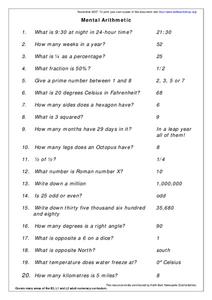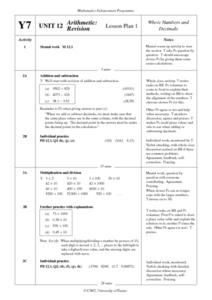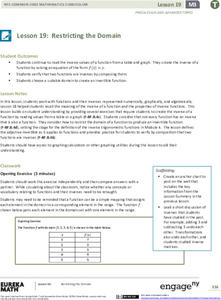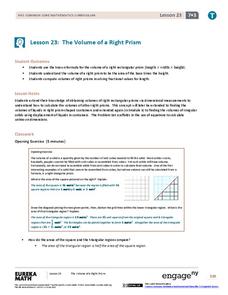Curated OER
Mental Arithmetic
For this math worksheet, students are read a series of questions. They answer them mentally. The questions and answers are on the worksheet.
Curated OER
Arithmetic: Revision
Students practice with a variety of simple equations involving addition, subtraction, multiplication and division. Explanation is followed by each block of equations given to solve. They are set loose to complete additional equations for...
Curated OER
Biblical Arithmetic
In this secondary mathematics worksheet, students solve a Biblical riddle where they fill in the missing words for each of the numbers listed. The one page worksheet contains one problem. Solution is provided.
Curated OER
MCC Arithmetic Word Search Puzzle
In this math worksheet, students find the words that are in the word search puzzle that focus upon the vocabulary that is from the theme of the sheet.
Curated OER
The Function Box
Students explore arithmetic and numerical patterns. After observing a teacher created function box, students describe a pattern and predict what will "come out" of the function box. They explore patterns such as geometric shapes,...
Curated OER
Discovering Growth Patterns
Students explain the differences between linear (arithmetic) and exponential (geometric) growth. They use worksheets imbedded in this lesson to help them make predicitions and graph data points.
Curated OER
Consecutive Numbers
Like all of the Problem Solving units, this one aims to introduce students to the underlying ideas of mathematics through a problem. The problem here requires a knowledge of arithmetic and the use of some algebra. In this unit we see how...
Curated OER
Ten Pennies
Students play logic and strategy games with pennies. In this pennies worksheet, students play one game called 'From counting to arithmetic', and one called 'Counting and mental math'.
Curated OER
Cryptography on the TI-83 Graphing Calculator
Students explore the history of cryptography. They assess function notation and transformation, matrix operations, and the fundamentals of modular arithmetic. Using graphing calculators, students develop their own encryption schemes.
Helping with Math
Addition - Three 3-Digit Numbers
There are 20 addition problems on this assignment, all of which require the addition of three three-digit numbers. All of them will require some regrouping to solve. This is terrific arithmetic practice to assign as homework. An answer...
Curated OER
Non-Calculator Maths Pack
For this math skills worksheet, students first read a one page information sheet about common errors in arithmetic calculations. Students then solve 39 multiplication problems with 3 digits. Students solve 29 long division problems with...
TryEngineering
Circuits and Boolean Expressions
Teach basic logic using Boolean operators. Young computer scientists learn about the operators NOT, AND, and OR, and how they can be expressed using Boolean notation, logic gates, or truth tables. Along the way, they learn about half...
Curated OER
Accelerated Arithmetic; Dividing Fractions
In this math worksheet, students divide fractions. Fractions are single digit fractions, both the numerator and denominator are single digits. Students use the method they have learned in class to perform the computation.
Curated OER
Accelerated Arithmetic; Convert to Decimals
In this math worksheet, learners convert each given fraction to a decimal number. Some of the decimal numbers will be non-terminating decimals. The three improper fractions have decimal answers that terminate, or they divide to be whole...
Curated OER
Basic Arithmetic
In this set of binary numbers worksheets, students complete twelve sets of problems. Students convert base 10 to binary numbers and vice versa, solve binary addition, subtraction, multiplication, and division problems and equations....
Noyce Foundation
Gym
Give the class a mental work out with an assessment task in which young mathematicians compare several gym membership options. They use substitution to calculate the cost for given numbers of months.
EngageNY
Changing Scales
Pupils determine scale factors from one figure to another and the scale factor in the reverse direction. Scholars compute the percent changes between three figures.
EngageNY
Chance Experiments with Outcomes That Are Not Equally Likely
The fifth portion of the 25-part series introduces probabilities calculated from outcomes that are not equally likely. Class members use tables to calculate probabilities of events, add outcome's probabilities, and find...
101 Questions
Coins in a Circle
Round and round you'll go! Learners watch as different-sized circles fill with coins. They collect data and then make a prediction about the number of coins that will fit in a large circular rug.
101 Questions
Red Carpet
Roll out the red carpet for an exemplary lesson. Using the dimensions of a rolled piece of carpet, learners calculate the dimensions of the flat sample. Pictures provide individuals with the information they need to make a valid conclusion.
EngageNY
Restricting the Domain
But what if the function cannot be inverted? Pupils continue to work with inverses of functions using tables, graphs, and algebraic equations. They restrict the domain of non-invertible functions to make them invertible. Using...
Flipped Math
Graphing Functions to Solve Equations
Intersections become solutions. Scholars watch a video on using a graphing calculator to find the solution to an equation in one variable. While watching the presentation, pupils practice working some of the examples and compare their...
EngageNY
Surface Area II
The class makes the connection between finding the area of a right prism and a right pyramid in the 23rd installment in a series of 28. The pupils find the surface area of figures created by stacked cubes and prisms with cutouts.
EngageNY
The Volume of a Right Prism
Does the volume formula work even if the measurements are not whole numbers? Class members work simple problems to find that the formula (area of the base) × (height) works for all prisms, independent of measurements and shape.























